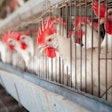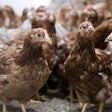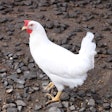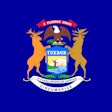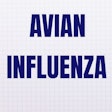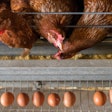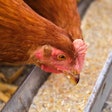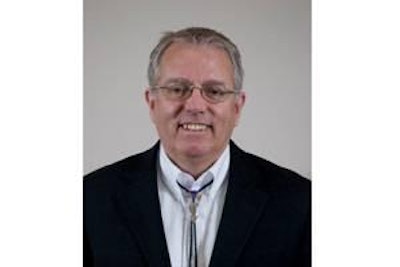
Tim Amlaw was appointed Vice President of the American Humane Certified Farm Animal Program in April 2010. The program was initiated and is administered by the American Humane Association, headquartered in Washington D.C., with offices in Englewood, Colorado. Amlaw has more than 35 years experience in agriculture and livestock production. Prior to joining American Humane Association in 2007 as the Program Manager of the American Humane Certified initiative he was the CEO of Beef Plus Inc. where he was responsible for a branded beef product distributed by Nobel-Sysco a food services company. He has extensive experience in government regulation and compliance in the beef industry and has taught agricultural education to high school and college students and continues to speak at national meetings and to serve on industry panels.
Egg Industry: Please explain the American Humane Association involvement in livestock welfare.
Tim Amlaw: American Humane Association has been involved with animal welfare since 1877 when our organization was instrumental in developing standards for transport of livestock. The AHA has been at the forefront of a number of major initiatives to protect children, pets and farm animals from cruelty abuse and neglect for over 130 years.
EI: How did the AHA become involved in the welfare of poultry flocks?
TA: The concept of a science-based set of standards and a complementary auditing program was developed prior to my joining the AHA in 2007. Discussions with Eggland’s Best and also the United Egg Producers established a need for an independent, reputable welfare organization to develop humane solutions equitable to both producers and consumers. It was felt that the legacy established by the AHA, together with their history of protecting livestock, pets and children in a constructive and non-confrontational manner would be beneficial to the success of a national program for poultry and livestock.
EI: Please indicate some of the drivers for the AHA program.
TA: The welfare of laying hens in the EU was established by the directive 1999/74/EC which established standards for types of housing, including enriched cages, confined floor units, aviaries and free-range. The LayWel project was established to produce a series of science-based reports on the welfare of laying hens housed under various systems in the EU. The LayWel report considered a series of seven packages including definitions and indicators of welfare, descriptions of housing systems, flock health, behavior and stress, productivity and quality and an assessment of integrated welfare.
EI: How have you positioned the AHA Certification Program?
TA: The American Humane Association has always projected a reasoned voice representative of the mainstream of our population. We respect the right of consumers to choose what they wish to eat. We feel strongly however that no producer has the right to abuse or neglect livestock. Our standards were influenced by developments and trends in the EU over the past 20 years where studies by universities and institutes yielded a wealth of scientific information to evaluate welfare. It was our objective to balance sound science and aspects of practical production to develop appropriate fact based standards and an effective third-party audit system, capable of handling millions of birds. The AHA receives regular input from scientists including Dr. Inma Estevez of Neiker-Tecnalia in Spain and from field studies in the Netherlands and from five locations in the U.S. Video camera studies are helpful in understanding the behavior of hens under commercial conditions. The Certification Program was extensively evaluated by major companies purchasing eggs and derived products and received their support.
EI: What are the advantages of AHA Certification to producers?
TA: We believe that the legacy and heritage of AHA provides credibility for our program. This is a major factor which is appreciated by large supermarket chains and industrial users of eggs and distinguishes the AHA program from competitors. We recognize that to be successful, the program must represent a combination of business concepts, the legacy component and above all our credibility. The AHA program provides producers with a valid and rigorous recognition of acceptable housing and operational procedures.
EI: Please describe your audit program.
TA: When we established the program we recognized the need to have experienced and qualified auditors. We prefer to audit to ISO principles and our auditors must have at least 12 years experience with a given species, preferably with a degree or equivalent training and qualification in some aspect of animal agriculture. Our program also incorporates video monitoring.
EI: How do you foresee development of the U.S. egg production industry?
TA: I believe the industry is in transition. This will obviously be consumer-driven with an increasingly greater emphasis on welfare. It is our belief that 30% of the industry will be housing hens in other than conventional cages in ten years time. The choices are obviously aviaries or enriched colony units. We recognize that since the advent of California Proposition 2 there has been considerable reluctance by producers to either re-cage or expand especially in states with constitutions that allow for ballot initiatives. We look forward to a resolution of the current situation so that the industry can move forward with confidence according to established standards for animal welfare based on scientific findings.
EI: In mid-December you addressed a letter to the National Organic Program questioning their approach to flock welfare. Would you like to comment on this?
TA: We questioned the science driving the direction in which they are heading. In effect, welfare has nothing to do with the organic status of a product. If science is the major criterion determining the organic status then we believe that the American Humane Association standards should form the basis of the NOSB requirements in the interest of standardization. If however the welfare aspect of the NOP is market driven and designed as a means to limit production, the integrity of the NOP is in question. We would not be favorable to any approach that is designed to exclude existing producers who have complied with organic standards to date and who may be faced with disqualification due to competition by imposing restrictions that have no scientific basis in behavior, physiology, health or safety.
EI: Do you have any message for the industry?
TA: The American Humane Association Certified Farm Animal Welfare program represents mainstream consumers and is based on choice and trust. We believe that establishing realistic evidence-based standards by panels of experienced independent scientists, coupled with an audit program implemented by trained personnel, serve the best interest of the stakeholders, industry, consumers, retailers and most importantly of animals.
EI: Thank you, Tim







